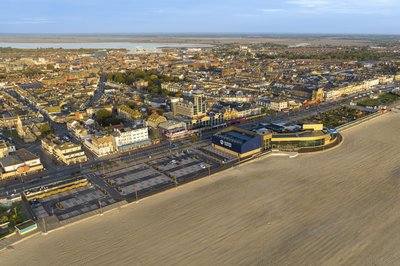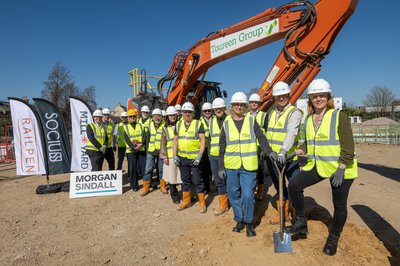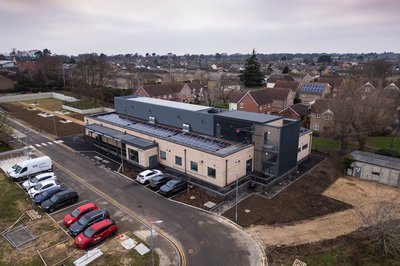Marine Parade Leisure Centre
The town of Great Yarmouth - a popular travel destination in the UK - has been embarking upon major regeneration. Part of this strategy included the demolition and rebuild of the Marina Leisure Centre. Once funding was agreed from a number of stakeholders including, the Government’s Getting Building, Sports England and the New Anglia Local Enterprise Partnership, the redevelopment of the Marina Leisure Centre was on its way and is a catalyst for revitalisation for Great Yarmouth
Key Stats
- New build leisure centre in Great Yarmouth
- Wet and dry leisure centre
- On budget
- Sea front development
- Customer Satisfaction 10/10
- Catalyst for revitalising the town
- Completed on time
At a Glance
Budget
£23.4m
Completion
August 2022
Location
Great Yarmouth
Framework
N/A
Sector
Leisure
Social value
£23.5 million
Sustainability
94% Waste Diverted from Landfill
The new Marina Centre project involved the design and construction of a brand new wet and dry leisure centre. The facility includes a 25m competition pool, accessibility pool and fun pool, complete with slides and play equipment.
Dry-side, the centre includes a four court sports hall with changing facilities, two gyms, spinning room, dance studios, a seaside café, climbing walls and a new 100 space surface car park.
Despite the difficulties faced through the COVID-19 pandemic and with a key subcontractor unfortunately suffering insolvency during this time, the team still completed the project on time and to the client budget.
Difficult ground conditions
Construction which is near the sea will yield extra challenges due to the sandy ground conditions which were amplified with this project due to working at basement level. As the team were five metres below the ground, the first consideration was to ensure excavations were safe. The installation of sheet piling guaranteed it didn’t collapse when working below the ground. The next risk was the water table below the site and planning the dewatering strategy in the excavation. The team pre planned this by digging a 1.5m hole and installing a prefabricated manhole chamber which monitored the water levels for a few months.
The results returned that the ground water was not tidal and that the fluctuations in levels were seasonal; meaning it was not frequent. The subsequent dewatering strategy entailed digging 1.5m deep wells around the perimeter of the sheet piled areas. Wells were all linked via plastic tubes which led to three pumps, all of which extracted water at a certain rate. The water was discharged at the other end of the site in a temporary soakaway. The soakaways slowly diverted the excess water away from the project which mitigated against any potential flooding and prevented damage to the project and its foundations.
Enduring and future proofed materials
Swimming pools by nature are complex, as they require many chemicals such as chlorine to prevent the spread of germs. However, the materials used in this build had to endure even harsher conditions during the construction phase due to being located right on the shoreline. This meant that interrogating the specifications and ensuring that elements are installed and treated correctly was key. Measures that came as a result included additional layers of protective coating on the steel frame and a schedule for annual cleaning on the building's aluminium cladding.
There were several innovative design features which helped with the functionality of the leisure centre and the futureproofing of the building. Waterproof concrete was used for the swimming pool as opposed to traditional Damp Proof Membrane (DPM). This is because it prevents mould and mildew from getting into the walls and floor which maintains the structural integrity and health of the building.
Ensuring design met Sports England standards
The team came into the project with a blank canvas, as the demolition works were completed by another contractor under another contract. The team acquired RIBA stage 4 drawings and although it was at an advanced design stage, it still required several considerations to ensure it was compliant with Sports England standards. This was hugely important to ensure the project was able to receive funding because of the wider use the leisure centre will have, which includes a competition standard 25m pool.
Through close collaboration with the consultants including leading architects Saunders Boston, the team ensured that the 25m pool access was redesigned to resolve conflict between ambulant and disabled access. The pool’s spectator seating area was also rationalised to provide 110 spaces. The steel frame was adapted to allow M&E services to pass through castellated beams which would maximize headroom and comply with Sport England’s 3.5m clear height requirement.
Social impact
The leisure centre has been a major asset to the community for over 40 years and therefore the team wanted to generate as much Social Value as possible locally. The project generated over £23.5 million of Social value which was a 101% return of the total project cost.
The surrounding community were kept engaged throughout the whole life of the project through newsletters and coffee mornings. Neighbours would attend the coffee mornings monthly and were able to engage in discussions, ask as many questions to the team as possible and have a first-hand look at the updates of their new leisure facility. Along with the coffee mornings, the team hosted two virtual site tours which included a video tour from two of the projects apprentices Cam and Brad, and an extensive overview of the job and the industry, by Danny Branson. Tour one was with four women and their project manager from the Women into Construction initiative. Tour two was completed with 23 stakeholders from Great Yarmouth.
Following the installation and completion of phase one of the steelwork the team celebrated this with a steel signing event. Great Yarmouth Borough Council ran a competition locally to give local school children the chance to be a part of the event. The lucky winner aged six was able to visit and have a tour of the site as well as making their mark by signing the steelwork.
The foresight and bravery to build this facility is to be applauded. This is the platform for it and we have targeted programmes to help get more people active locally. For us, this centre will be an overall experience as well as employment opportunities – we’ve already employed over 100 people and there’s more to come, so lots of opportunities for local people which is really positive. I want to thank the council and Morgan Sindall for the great job."
Matt Wickham, Freedom Leisure
Gallery
Related News
NEWS

Building Community in Great Yarmouth
The UK's coastal communities face unique challenges. Around 10% of the nation's population lives in coastal towns and cities – places that have experienced decades of decline and where …
NEWS

Groundbreaking ceremony marks official start on site for Mill Yard development
A major milestone was reached on Monday 7 April as local councillors, residents, members of the community and the development project team all attended an official groundbreaking ceremony for …
NEWS

Morgan Sindall completes Newmarket Community Diagnostic Centre
A new Community Diagnostic Centre (CDC) at the Newmarket Community Hospital has been completed by Morgan Sindall Construction and handed over to West Suffolk NHS Foundation Trust (WSFT).













